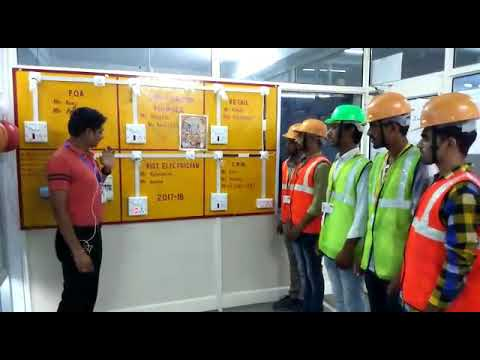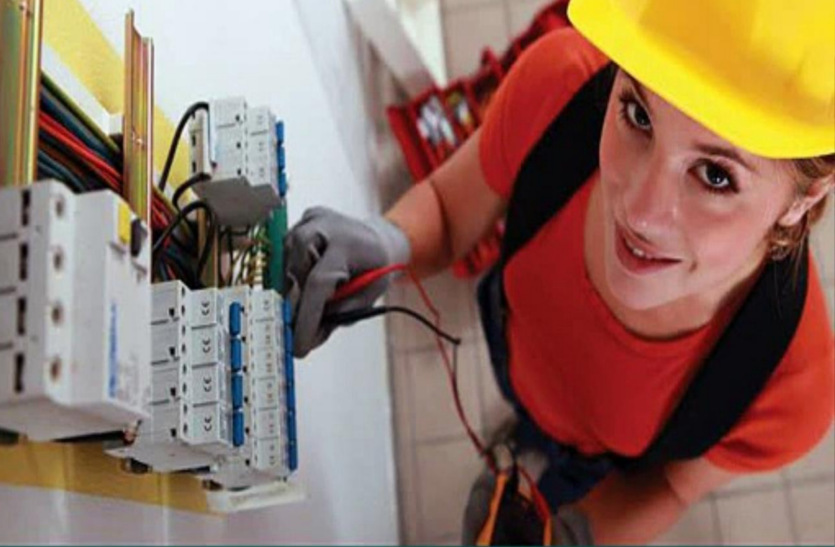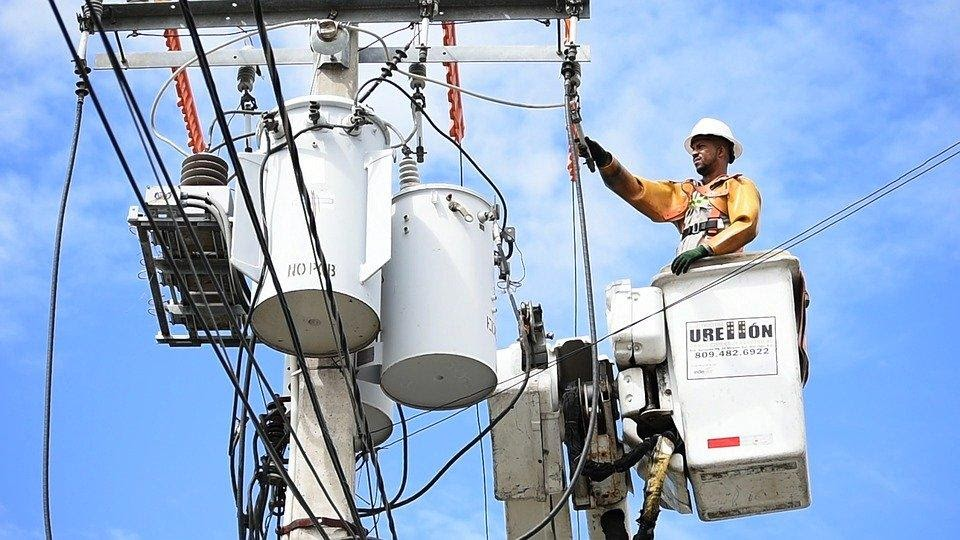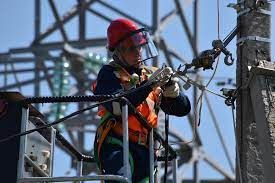Assistant Electrician ( 6 month course)
Assistant Electrician click here
Brief Job Description
Assistant Electrician assists the electrician in electrical work for the installation, repair, and maintenance of
temporary LV electrical connections in the construction sites and permanent connections at residential and commercial buildings. The individual is engaged in laying conduits for LV single phase wiring.

Personal Attributes
The individual is expected to be physically fit and should be able to work across various locations in
extreme weather/site conditions. The person should be team-oriented and safety-driven.
Handle hand and power tools relevant to construction
electrical works
Description
This unit describes the knowledge and the skills required to select and use hand, power tools and electrical devices relevant to construction electrical works
Scope
The scope covers the following :
Handle hand/power tools for electrical works.
Elements and Performance Criteria
Handle hand/power tools for electrical works.
To be competent, the user/individual on the job must be able to:
PC1. perform basic checks on power tools prior to use
PC2. handle hand/power tools for establishing/ terminating electrical connections as per
requirement
PC3. use appropriate tools to trace out short circuits/faults and leakages in electrical wiring
PC4. use measuring instruments to measure size and dimension of wires, conduits as per
electrical installation or maintenance work requirement
PC5. use hand/ power tools to cut, and bend wire and conduit as per electrical installation or
maintenance work requirement
PC6. use appropriate tools to splice wires by stripping insulation from terminal leads and twisting
wires together
PC7. use appropriate hand/power tools to thread conduit ends, connect couplings, and fabricate
and secure conduit support brackets
PC8. use appropriate electrical measuring devices like ammeter, voltmeter, meggers etc.to
examine electrical units for power interruptions/ continuity
PC9. use electrical devices such as starters, circuit breakers, relays as per equipment/ wiring
installation rating or current rating
PC10. use diagnostic devices like multi-meter, tong tester, earth tester or similar devices to install,
repair power connections
PC11. perform maintenance and upkeep of relevant tools and devices after use
Knowledge and Understanding (KU)
The individual on the job needs to know and understand:
KU1. standard practices for electrical works
KU2. safety rules and regulations for handling required electrical tools, equipment, and materials
KU3. importance of personal protection including the use of related safety gears & equipment in
accordance with organizational norms
KU4. service request procedures for tools, materials and equipment as per organizational norms
KU5. single line diagram (SLD), and schematics, wiring diagrams of electrical connections
including wiring symbols
KU6. manufacturers guideline

s/ specifications for use of hand and power tools and measuring
devices
KU7. how to use hand, power tools to carry out required activities
KU8. how to use electrical measuring and diagnostic devices to undertake required tests to install
and maintain electrical circuits
KU9. basic principles of electrical current flow, fundamental terms like resistance, temperature,
cross-section of conductor and their relations
KU10. basic concept of AC and DC
KU11. electrical theory such as Ohms law, Amperes law, electromagnetic field and its effects
KU12. types of wires, cables based on their insulation and their respective uses in LV electrical
works
KU13. features of resistors, switches, fuses and various circuit protection devices
KU14. selection, use and maintenance of electrical measuring devices like digitalmultimeter, earth
tester, megger, tong tester etc.
KU15. operating characteristics and application of electrical test equipment
KU16. method to trace out short circuit, power interruption/ continuity usingdiagnostic
tools/devices
Generic Skills (GS)
User/individual on the job needs to know how to:
GS1. write in at least two languages, preferably the local language at the site and basic English
GS2. read SLDs, work, and safety-related instructions/signboards in one or more languages,
preferably in the local language of the site
GS3. speak in one or more language, preferably one of the local language at site
GS4. listen attentively to instructions communicated by supervisors
GS5. communicate orally and efficiently with team members
GS6. resolve any conflict within the teammates
GS7. analyze the safety aspect of the workplace
GS8. plan work to achieve productivity as per the direction /close supervision of superiors
GS9. ensure work is done within time and as per desired quality based on instructions provided by
superiors

GS10. evaluate the complexity of the tasks
GS11. identify any violation of safety norms during the work
Install temporary lighting arrangement at construction sites
Description
This unit describes the knowledge and the skills required to install temporary lighting arrangement at
construction sites
Scope
The scope covers the following :
Installation of temporary lighting arrangements at construction sites.
Maintenance of installed lighting arrangement.
Elements and Performance Criteria
Installation of temporary lighting arrangement at construction sites.
To be competent, the user/individual on the job must be able to:
PC1. check cable, conduits , lights, sockets, temporary power distribution panels at power source
and other required fixtures and accessories as per manufacturers guidelines and
specification
PC2. lay cables through ducts or conduits, underground or through poles (overhead) as per plans
and instructions
PC3. select the type and wattage of lights considering illumination requirement at worksite and
install them at secured positions
PC4. fix lights and its accessories, brackets, bulkheads with screws and bolts or by other standard
means, pull wires through conduit leading to connection boxes, temporary panels/
distribution boards or other temporary electrical terminals
PC5. extend/ join LV electrical cable using straight through joints, splicing them together and
secure joints by applying PVC insulation tapes, caps or by other safe method as and when
necessary
PC6. carry out termination of LV cables selecting the right method as per standard practice
PC7. work safely as per electrical safety guidelines provided by manufacturer, standard safety
practice or organizational safety norms while establishing or disconnecting live electrical
connections
PC8. upkeep of all relevant key electrical tools and fixtures
PC9. tag embedded, exposed electrical lines and other key equipment appropriately
Maintenance of installed lighting arrangements.
To be competent, the user/individual on the job must be able to:
PC10. shift light at various locations during construction activity as per requirement
PC11. repair and replace light arrangements as per instruction or requirement
PC12. replace burned out bulbs, light units and ballast in light fixtures as needed
PC13. carry out relevant tests to trace out power interruptions/ continuity at lighting arrangements
PC14. replace damaged cable, other relevant parts as and when necessary
PC15. replace faulty circuit breakers, fuses, switches, electrical and electronic components and
wire as per requirement
PC16. perform preventive maintenance on diesel generators at site provided for temporary lighting
(if any) at scheduled intervals as per direction of concerned authority
Knowledge and Understanding (KU)
The individual on the job needs to know and understand:
KU1. standard practices for establishing temporary lighting arrangement at sites
KU2. safety rules and regulations for handling relevant tools, equipment, and materials for
electrical works in accordance with organizational norms
KU3. importance of personal protection including the use of related safety gears & equipment
KU4. service request procedures for tools, materials and equipment as per organizational norms
KU5. wiring symbols of single and three phase electrical wiring
KU6. single line diagram (SLD), and schematics, wiring diagrams of electrical connections
KU7. manufacturers guidelines/ specifications for use of hand, power tools and measuring devices
KU8. how to use hand and power tools to carry out required activities
KU9. how to use electrical measuring/ diagnostic devices to undertake required tests to install and
maintain electrical circuits
KU10. electrical units of measurements and their signs (such as Watt, Ampere, Ohm, volt etc.)
KU11. method of termination of wires and cables during installation and maintenance
KU12. basic principles for setting and maintaining temporary lighting and other related electrical
systems under LV connection
KU13. basic electrical theory such as ohms law, amperes law, electromagnetic field and its effects
KU14. the basic concept of single-phase and three phase LV connections and their uses
KU15. the basic concept of AC and DC
KU16. basic characteristics of series, parallel and combination circuits and test to be performed in
the same
KU17. basic concept of bridge circuits, their connections and tests to be carried out in the same
KU18. the basic principle of electrical current flow, fundamental terms like resistance, temperature,
cross-section of conductors and their relations
KU19. types of cables based on their insulation, their respective uses in electrical works and
selection of cable depending upon the circuit load requirement
KU20. the process of joining of LV cable by straight-through joints
KU21. properties of conductors, insulators, and semiconductors
KU22. selection, use and maintenance of electrical measuring devices like digital multimeter, earth
tester, megger, tong tester etc.
KU23. method to trace out short circuit, power interruption/ continuity using diagnostic
tools/devices
Generic Skills (GS)

User/individual on the job needs to know how to:
GS1. write in at least two languages, preferably the local language at the site and basic English
GS2. read SLDs, work and safety-related instructions/signboards in one or more languages,
preferably in the local language of the site
GS3. speak in one or more language, preferably one of the local language at site
GS4. listen attentively to instructions communicated by supervisors
GS5. communicate orally and efficiently with team members
GS6. analyze the safety aspect of the workplace
GS7. resolve any conflict within the teammates
GS8. plan work to achieve productivity as per the direction /close supervision of superiors
GS9. ensure work is done within time and as per desired quality based on instructions provided by
superiors
GS10. evaluate the complexity of the tasks
GS11. identify any violation of safety norms during the work
Assist in LV(low voltage) electrical wiring at permanent
structures
Description
This unit describes the knowledge and the skills required to install LV electrical wiring at permanent
structures
Scope

The scope covers the following :
Provide assistance for LV electrical wiring work in permanent structures
Elements and Performance Criteria
Provide assistance for LV electrical wiring work in permanent structures
To be competent, the user/individual on the job must be able to:
PC1. select house wiring components (such as wires, flexible and rigid conduits, PVC raceways,
wooden battens, clamps etc. ) according to their specification / size
PC2. read and interpret single phase LV wiring diagram
PC3. carry out necessary linear measurement to cut, bend, join conduits and cables and use them
as per requirement or instruction
PC4. lay conduit through RCC structures (slabs, beams, walls) or through chased wall (brick wall)
surface as per instruction
PC5. lock conduit pipe in its location by means of clamp or other standard means as per
instruction
PC6. pull, push wires through conduits in order to expose them at desired locations as per
requirement
PC7. perform drilling and cutting using appropriate tools as per requirement
PC8. handle ,shift and assist in fixing electrical fixtures and fittings as per instructions
PC9. carry out termination of cables safely as per instruction
PC10. test electrical circuit during and post wiring activity using appropriate tools as per direction
of electrician
PC11. assist in carrying out electrical earthing work by installing earthing components as per
instructions
Knowledge and Understanding (KU)
The individual on the job needs to know and understand:
KU1. standard practices for laying conduit and cable for LV single phase wiring work
KU2. safety rules and regulations for handling and storing required electrical tools, equipment,
and materials
KU3. personal protection including the use of related safety gears & equipment in accordance
with organizational norms
KU4. service request procedures for tools, materials and equipment as per organizational norms
KU5. procedure for maintenance of tools and equipment
KU6. single line diagram (SLD), and schematics, wiring diagrams of electrical connections
including wiring symbols used in single and three phase wiring
KU7. manufacturers guidelines/ specifications for the use of hand/power tools and measuring
devices
KU8. how to use hand and power tools to carry out required activities
KU9. how to use electrical measuring/ diagnostic devices to undertake required tests to install and
maintain electrical circuits
KU10. the procedure of selection of LV cable depending upon the circuit load requirement and
types of cables based on their insulation and their respective uses in electrical works
KU11. electrical units of measurement and their symbols (such as Watt, Ampere, Ohm, volt etc.)
KU12. method of termination of wires and cables during installation and maintenance
KU13. basic principles for setting and maintaining temporary lighting and other related electrical
systems

KU14. electrical theory such as ohms law, amperes law, electromagnetic field and its effects
KU15. the basic concept of single-phase and three-phase LV connections including their uses
KU16. the basic concept of AC and DC
KU17. basic characteristics of series, parallel and combination circuits and test to be performed on
the same
KU18. basic concept of bridge circuits, their connections and tests to be carried out in the same
KU19. the basic principle of electrical current flow, fundamental terms like resistance, temperature,
cross-section of conductor and their relations
KU20. properties of conductors, insulators, and semiconductors
KU21. selection, use and maintenance of electrical measuring devices like digital multimeter, earth
tester, megger, tong tester etc.
KU22. method to trace out short circuit, power interruption/ continuity using diagnostic
tools/devices
Generic Skills (GS)
User/individual on the job needs to know how to:
GS1. write in at least two languages, preferably the local language at the site and basic English
GS2. read SLDs, work and safety related instructions/signboards in one or more languages,
preferably in the local language of the site
GS3. speak in one or more language, preferably one of the local language at site
GS4. listen attentively to instructions given by supervisor
GS5. communicate orally and efficiently with team members
GS6. analyze the safety aspect of the workplace
GS7. plan work and organize required resource effectively
GS8. ensure work is done within time and as per desired quality based on instructions provided by
superiors
GS9. resolve any conflict within the teammates
GS10. evaluate the complexity of the tasks
GS11. identify any violation of safety norms during the work
Assemble, install and maintain temporary LV electrical panels (distribution boards) at construction site
Description
This unit describes the knowledge and the skills required to assemble, install, and maintain temporary LV
electrical panels (distribution boards) at construction site.
Scope
The scope covers the following :
Assemble temporary LV power distribution panels (distribution boards)
Repair/ replace faulty parts/ fixtures as per requirement
Elements and Performance Criteria

Assemble temporary LV power distribution panels (distribution boards)
To be competent, the user/individual on the job must be able to:
PC1. read relevant SLDs(Single Line Diagrams), instructions, safety guidelines, manufacturers
specifications prior to assembling temporary panel/ distribution boards
PC2. install required fixtures like power sockets, switches, wires, MCBs(Miniature Circuit Breakers)
of appropriate specification as per circuit load requirement
PC3. ensure tightness and safe working condition of wires, fixtures prior to the connection of the
assembly with power source
PC4. connect DB(Distribution Board) to main power cable and perform standard tests to ensure its
safe and desired working
PC5. place and secure the distribution board against external damaging agents like water, fire etc.
PC6. carry out proper termination of cables as per standard practice while connecting to the
sockets of the panel
PC7. carry out earthing of the panels as per standard procedure
PC8. check and ensure necessary tagging and barricading near the live/ active electrical
distribution boards
Repair/ replace faulty parts/ fixtures as per requirement
To be competent, the user/individual on the job must be able to:
PC9. carry out visual inspection of the live/ active board regularly to ensure safe working condition
of all components
PC10. ensure that the live connections get discontinued after completion of daily construction
works in order to minimize energy wastage and enhance working efficiency of electrical units
PC11. respond promptly to failure/ damage or malfunctioning of panel or any of its components
PC12. carry out necessary tests in order to determine root cause of failure
PC13. notify concerned authorities prior to shut down, deactivation or repair of the electrical unit
PC14. replace/ repair faulty components as per SLD, instructions, safety guidelines and
manufacturers specifications
PC15. document and keep records relevant to maintenance/ repair of panels as per organizational
norms
PC16. isolate the panel safely and shift to another location as per requirement
Knowledge and Understanding (KU)
The individual on the job needs to know and understand:
KU1. standard practices for repairing and maintaining common electrical equipment
KU2. safety rules and regulations for handling required electrical tools, equipment and materials
KU3. importance of personal protection including the use of related safety gears & equipment in
accordance with organizational norms
KU4. service request procedures for tools, materials and equipment as per organizational norms
KU5. procedure for maintenance of tools and equipment
KU6. single line diagram (SLD), and schematics, wiring diagrams of electrical connections
including wiring symbols of single and three phase wiring
KU7. how to use electrical measuring/ diagnostic devices to undertake required tests to install and
maintain electrical circuits
KU8. selection of cable depending upon the circuit load requirement and insulation
KU9. electrical units of measurements and their signs (such as Watt, Ampere, Ohm, volt, etc.)
KU10. method of termination of wires and cables during installation and maintenance
KU11. basic principles for setting and maintaining temporary lighting and other related electrical
systems
KU12. electrical theory such as ohms law, amperes law, electromagnetic field and its effects
KU13. concept of single-phase and three-phase LV connections and their uses
KU14. the basic concept of AC and DC
KU15. characteristics of series, parallel and combination circuits and test to be performed in the
same
KU16. concept of bridge circuits, their connections and tests to be carried out in the same
KU17. the basic principle of electrical current flow, fundamental terms like resistance, temperature,
the cross-section of conductor and their relations
KU18. the process of joining of LV cable by straight-through joints and other standard procedures
KU19. properties of conductors, insulators, and semi- conductors
KU20. selection, use and maintenance of electrical measuring devices like digital multimeter, earth
tester, megger, tong tester etc.
KU21. method to trace out short circuit, power interruption/ continuity using diagnostic
tools/devices
Generic Skills (GS)
User/individual on the job needs to know how to:
GS1. write in at least two languages, preferably the local language at the site and basic English
GS2. read SLDs, work and safety-related instructions/signboards in one or more languages,
preferably in the local language of the site
GS3. speak in one or more language, preferably one of the local language at site
GS4. listen attentively to instructions communicated by supervisors
GS5. communicate orally and efficiently with team members
GS6. analyze the safety aspect of the workplace
GS7. plan work and organize required resource effectively
GS8. ensure work is done within time and as per desired quality based on instructions provided by
superiors
GS9. resolve any conflict within the teammates
GS10. evaluate the complexity of the task
GS11. identify any violation of safety norms during the work
Work effectively in a team to deliver desired results at the workplace
Description
This unit describes the skills and knowledge required to work effectively within a team to achieve the
desired results
Scope
The scope covers the following :
Interact and communicate in an effective manner
Support co-workers to execute the project requirements
Practice inclusion
Elements and Performance Criteria
Interact and communicate in an effective manner
To be competent, the user/individual on the job must be able to:
PC1. pass on work related information/ requirement clearly to the team members
PC2. inform co-workers and superiors about any kind of deviations from work
PC3. report any unresolved problem to the supervisor immediately
PC4. obtain instructions from superiors and respond on the same
PC5. communicate to team members/subordinates for appropriate work technique and method
PC6. seek clarification and advice as per the requirement
Support co-workers to execute the project requirements
To be competent, the user/individual on the job must be able to:
PC7. hand over the required material, tools, tackles, equipment and work fronts timely to
interfacing teams
PC8. work together with co-workers in a synchronized manner
Practice inclusion
To be competent, the user/individual on the job must be able to:
PC9. maintain cultural inclusivity at work place
PC10. maintain disability friendly work practices
PC11. follow gender neutral practices at workplace
PC12. address discriminatory and offensive behavior in a professional manner as per
organizational policy
Knowledge and Understanding (KU)
The individual on the job needs to know and understand:
KU1. own roles and responsibilities
KU2. importance of effective communication
KU3. the consequence of poor teamwork on project outcomes, timelines, safety at the
construction site, etc.
KU4. different modes of communication used at workplace
KU5. importance of creating healthy and cooperative work environment among the gangs of
workers
KU6. different activities within the work area where interaction with other workers is required
KU7. applicable techniques of work, properties of materials used, tools and tackles used, safety
standards that co-workers might need as per the requirement
KU8. importance of proper and effective communication and the expected adverse effects in case
of failure relating to quality, timeliness, safety, risks at the construction project site
KU9. importance and need of supporting co-workers facing problems for the smooth functioning of
work
KU10. the fundamental concept of gender equality
KU11. how to recognize and be sensitive to issues of disability, culture and gender
KU12. legislation, policies, and procedures relating to gender sensitivity and cultural diversity
including their impact on the area of operation
Generic Skills (GS)
User/individual on the job needs to know how to:
GS1. write in at least one language, preferably in the local language of the site
GS2. read the communication regarding work completion, materials used, tools and tackles used,
the resource required, etc,
GS3. speak in one or more languages, preferably in one of the local language of the site
GS4. listen and follow instructions / communication shared by superiors/ co-workers regarding
team requirements or interfaces during work processes
GS5. communicate orally and effectively with co-workers considering their educational and social
background
GS6. decide on what information is to be shared with co-workers within the team or to the
interfacing gang of workers
GS7. plan work and organize the required resources in coordination with team members
GS8. complete all assigned task in coordination with team members
GS9. take initiative in resolving issues among co-workers or report the same to superiors
GS10. ensure best ways of coordination among team members
GS11. evaluate the complexity of task and determine if any guidance is required from superiors
Plan and organize work to meet expected outcomes
Description
This unit describes the knowledge and the skills required for an individual to plan and organize own work in order to meet expected outcome
Scope
The scope covers the following :
Plan and prepare for work
Organise required resources as per work plan
Complete work as per the plan
Elements and Performance Criteria
Plan and prepare for work
To be competent, the user/individual on the job must be able to:
PC1. identify the targets and timelines set by superiors
PC2. determine the work requirements corresponding to
task(drawings/schedules/instructions/methodology), safety, tools and equipment prior to
commencement of task
PC3. plan the work by analyzing the required outcomes, work procedures, allotted time, resource
availability and known priorities
PC4. prepare the work areas in coordination with team members
PC5. plan for waste collection and disposal prior to and after completion of work
Organize required resources as per work plan
To be competent, the user/individual on the job must be able to:
PC6. arrange the required manpower prior to commencement of work
PC7. organize the required materials, tools and tackles required for the task
Complete work as per the plan
To be competent, the user/individual on the job must be able to:
PC8. engage allocated manpower in an appropriate manner
PC9. employ correct tools, tackles and equipment for the desired work
PC10. provide guidance to the subordinates to obtain desired outcome
PC11. use resources in an optimum manner to avoid any unnecessary wastage
PC12. use tools, tackles and equipment carefully to avoid damage
PC13. ensure the work processes adopted are in line with the specified standards and instructions
PC14. complete the work with the allocated resources within specified time
PC15. clean and organize the workplace after completion of task
Knowledge and Understanding (KU)
The individual on the job needs to know and understand:
KU1. importance of proper housekeeping including safe waste disposal
KU2. policies, procedures and work targets set by superiors
KU3. how to identify work activities that need to be planned and organized
KU4. how to determine the task requirements
KU5. how to determine the quality requirements related to the task
KU6. how to undertake all aspect of planning and organizing the task, including interpretation of
task, reading drawing/schedules, arranging resources, reporting problems etc.
KU7. how to implement the planned activities
KU8. how to use available resources in a judicious and appropriate manner to minimize wastages or
damage
Generic Skills (GS)
User/individual on the job needs to know how to:
GS1. write in one or more language, preferably the local language at the site
GS2. read communication from co-workers, superiors and notices from other departments as per
requirement of the level
GS3. speak in one or more language, preferably one of the local language at the site
GS4. follow communication shared by co-workers regarding standard work processes, resources
available, timelines, etc.
GS5. communicate effectively with co-workers and subordinates
GS6. decide on what sequence is to be adopted for execution of work
GS7. plan and organize the materials, tools, tackles and equipment required to execute the work
GS8. complete all assigned task with proper planning and organizing
GS9. analyze areas of work which could result in a delay of work, wastage of material or damage
to tools and tackles
GS10. evaluate potential solutions to minimize avoidable delays and wastages at the construction
site
Work according to personal health, safety and environment protocols at construction site
Description
This NOS covers the skill and knowledge required for an individual to work according to personal health,
safety and environmental protocols at construction site
Scope
The scope covers the following :
Follow safety norms as defined by organization
Adopt healthy & safe work practices
Implement good housekeeping and environment protection process and activities
Follow infection control guidelines as per applicability
Elements and Performance Criteria
Follow safety norms as defined by the organization
To be competent, the user/individual on the job must be able to:
PC1. identify and report any hazards, risks or breaches in site safety to the appropriate authority
PC2. follow emergency and evacuation procedures in case of accidents, fires, natural calamities
PC3. follow recommended safe practices in handling construction materials, including chemical
and hazardous material whenever applicable
PC4. follow all the protocols and safety techniques conveyed during safety awareness programs
like Tool Box Talks, safety demonstrations and mock drills conducted at the site
PC5. select and operate different types of fire extinguishers corresponding to various types of fires
as per EHS guideline
PC6. identify near miss, unsafe condition and unsafe act
Adopt healthy & safe work practices
To be competent, the user/individual on the job must be able to:
PC7. use appropriate Personal Protective Equipment (PPE) as per work requirements for : Head
Protection, Ear protection, Fall Protection ,Foot Protection, Face and Eye Protection, Hand
and Body Protection , and Respiratory Protection (if required)
PC8. handle all required tools, tackles, materials and equipment safely
PC9. follow safe disposal of waste, harmful and hazardous materials as per EHS guidelines
PC10. check and install all safety equipment as per standard guidelines
PC11. follow safety protocols and practices as laid down by site EHS department
PC12. obtain “height pass” clearance for working at heights
Implement good housekeeping practices
To be competent, the user/individual on the job must be able to:
PC13. collect, segregate and deposit construction waste into appropriate containers based on their
toxicity or hazardous nature
PC14. apply ergonomic principles wherever required
Follow infection control guidelines as per applicability
To be competent, the user/individual on the job must be able to:
PC15. follow recommended personal hygiene, workplace hygiene and sanitization practices
PC16. clean and disinfect all materials, tools and supplies before and after use
PC17. report immediately to concerned authorities regarding signs and symptoms of illness of self
and others
Knowledge and Understanding (KU)
The individual on the job needs to know and understand:
KU1. reporting procedures in cases of breaches or hazards for site safety, accidents, and
emergency situations as per guidelines
KU2. types of safety hazards at construction sites
KU3. basic ergonomic principles as per applicability
KU4. the procedure for responding to accidents and other emergencies at site
KU5. use of appropriate personal protective equipment based on various working conditions
KU6. importance of handling tools, equipment, and materials as per applicable norms
KU7. effect of construction material on health and environments as per applicability
KU8. various environmental protection methods as per applicability
KU9. storage of waste including non-combustible scrap material and debris, combustible scrap
material and debris, general construction waste and trash (non-toxic, non-hazardous), any
other hazardous wastes and any other flammable wastes at the appropriate location
KU10. how to keep the workplace neat and tidy so as to be safe
KU11. how to use hazardous material in a safe and appropriate manner as per applicability
KU12. types of fire
KU13. procedure of operating different types of fire extinguishers
KU14. safety relevant to tools, tackles, and equipment as per applicability
KU15. housekeeping activities relevant to task
KU16. ways of transmission of infection
KU17. ways to manage infectious risks at the workplace
KU18. different methods of cleaning, disinfection, sterilization, and sanitization
KU19. symptoms of infection like fever, cough, redness, swelling, and inflammation
Generic Skills (GS)
User/individual on the job needs to know how to:
GS1. write in at least one language, preferably in the local language of the site
GS2. fill safety formats for near miss, unsafe conditions and safety suggestions
GS3. read in one or more language, preferably in the local language of the site
GS4. speak in one or more language, preferably in one of the local language of the site
GS5. listen to instructions/communication shared by site EHS and superiors regarding site safety,
and conducting the toolbox talk
GS6. identify potential safety risks and report to the appropriate authority
GS7. assess and analyze areas which may affect health, safety and environment protocol on the
site








